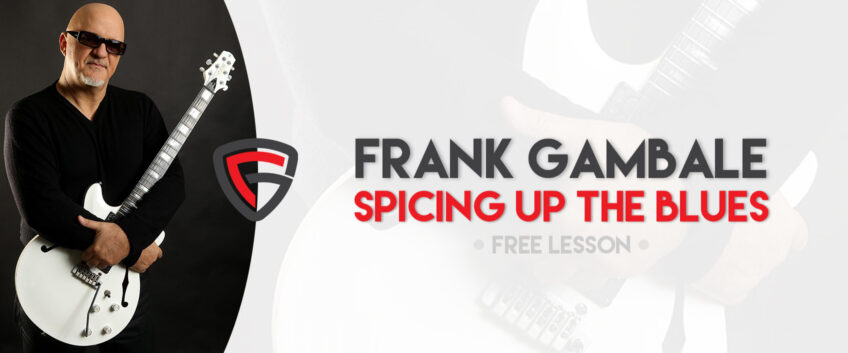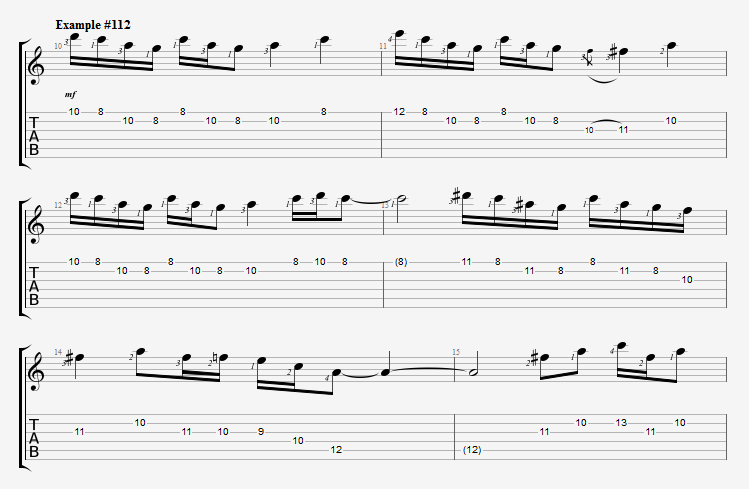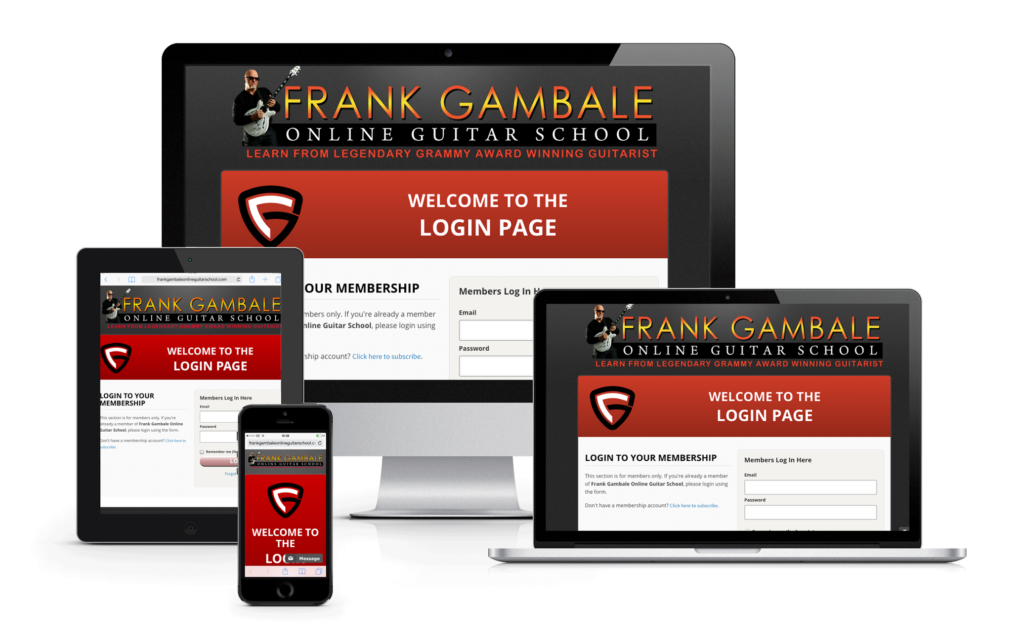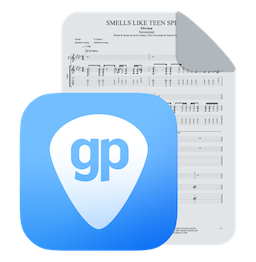
Spice Up your Blues Guitar Playing with Frank Gambale
In this lesson, Frank Gambale focuses on spicing up the Blues improvisation! This lesson is specially designed for intermediate to advanced guitar players. Make sure to download the Guitar Pro tabs to learn the licks along with the videos. Enjoy!
Sign up now to receive 3 free Blues video lessons from Frank Gambale. Also, make sure to look at his complete course (10.5 hours long) on his product page. Guitar Pro users: enjoy 30% off on the Frank Gambale catalog with the coupon code “guitarpro30” until April, 18.
The course is from Beginner to Advanced. This excerpt is from Part 10 of the 12-part course, a point in the course where Frank launches off into more advanced concepts. For students who do the course from the beginning, they will be completely ready for this part!
Frank Gambale Blues Demonstration
Frank Gambale Lesson Excerpt

“frank-gambale-tabs.zip”
(click on the image to download the Guitar Pro tabs from the videos above)
Lesson transcript
Now, we’re going to learn to play the Blues with lots of extras. It may seem out for some, but purists will certainly not approve, and others will think it the coolest, whichever way you view it, it is definitely not boring. A lot of folks play the Blues right inside the Blues pentatonic/scale and never waver from it, and that’s great!
I have covered a lot of that material and so now, for those of you who think, well, what other stuff can I do in a Bluesy way that is not necessarily straight-up Blues? This and successive chapters are for you folks!
For now, we’ll stay with the standard 3-chord Blues 12 Bar progression and see how we can spice that up.
One of the first slippery and outside things I like to do is based on something that happens all the time while playing in the standard blues chord progression, but very few musicians act upon what the chords suggest when they play the single lines in a solo.
Let me clarify what I’m talking about (what the heck is he talking about?)… yes… let me clarify.
Ok, here it is an informational gem. What I am talking about happens between the 1st chord of the Blues and the second chord of the Blues namely between the A7 and the D7 chords. As I mentioned before, a lot of musicians play an Eb7 right before the D7 (up a half step or one fret). Let’s get a visual representation.
Example #109 – The b5 passing chord
Now, I’m going to make a lot of fuss over the two beats of Eb7 right before the 5th bar going into the solid IV chord D7. What I am about to say applies also to the Eb7 going into the 2nd bar.
Why make such a fuss? Well because it’s a perfect opportunity to play the scale up a half step too. It’s interesting again to note that many folks play it without hesitation as a passing chord but very few take advantage of the linear possibilities of this move.
OK then, what scale can we use for this passing Eb7? Before I answer that I want to share one more informational gem! Look really closely at the A7 and then the Eb7. You may have already noticed that the only thing that changed was the bass note.
A7 = A G and C# (Root, b7 and 3rd the essentials of a dominant 7 chord)
Eb7 = Eb G and Db (Db = C#) ( Root, 3rd and b7th ).
Let’s look at these voicings up close. I will make the Eb7 into an Eb9 which will make it even clearer what is going on here.
Example #110 – Comparing Eb9 and A7 altered
Notice how the G and C# swap roles between the A7 and Eb7. The 3rd of the A7 becomes the b7 of the Eb7 and the 3rd of the A7 becomes the b7 of the Eb7, weird huh?
Notice also that these two chords are basically the same except for the root. When the bass is Eb it’s an Eb9 chord. When the bass moves a tritone or b5th away to A, it becomes an A7 altered chord. The precise name is A7 with a #5 and a b9, A7#5b9. A7#5b9 = Eb9 all but the roots.
Now some might say, well, the scale for the Eb7 should simply be the Eb Mixolydian, or just play an Eb Blues scale for 2 beats and be done with it. Yes, you could do that but there is a scale that represents the move much better.
The scale is Eb Lydian b7 or A Super Locrian depending on which root is used to visualize the chord change. I am going to suggest that we visualize the scale as Eb Lydian b7 because it’s only one note different from the Eb Mixolydian scale.
Another name for Lydian b7 could be Mixolydian #4. The reason it’s called Lydian is because it’s the 4th mode of Melodic Minor and the fourth mode is Lydian in Major scale so the logic follows on with the Melodic Minor scale too. I’ll explain this later. For now, let’s compare the scales.
Eb Mixolydian = Eb F G Ab Bb C and D ( 1, 2, 3, 4, 5, 6, b7 from Eb )
Eb Lydian b7 = Eb F G A Bb C and D ( 1, 2, 3, #4,5, 6, b7 from Eb )
Notice that the only difference is that the Lydian b7 keeps the A natural, which, after all, is the original root key of this Blues progression, so, it actually sounds more connected and better retaining the A instead of playing an Ab.
So now, the scale that Eb Lydian b7 comes from is the Bb Melodic Minor scale which is 1, 2, b3, 4, 5, 6, 7 from Bb. Same as Bb Major scale with a minor 3rd. Eb Lydian b7 is the 4th mode of Bb Melodic Minor. A Super Locrian is the 7th mode of Bb Melodic Minor. The 4th and the 7th of Bb Melodic Minor are the notes Eb and A, which are the roots of the two chords we are studying. The 7th position Melodic Minor is where many altered dominant chords are such as 7#5b9. The 4th position is standard dominant chords such as 9th. Both these chords have the same parent scale.
That’s enough info for now, let’s put this scale into action, and let’s start spicing up the Blues! This Lydian b7 is so much fun to use it becomes infectious. You’ll be outlining linearly what happens so often while playing the chords.
Onward and upward!
Example #112 – Lick #2 Eb9 passing chord with Eb Major/C minor Pentatonic
Discover the Frank Gambale Online Guitar School
Sign up now to receive 3 free Blues video lessons from Frank Gambale. Also, make sure to look at his complete course (10.5 hour long) on his product page.
Guitar Pro users: enjoy 30% off on the Frank Gambale catalog with the coupon code “guitarpro30” until March, 18.
Follow Frank Gambale on…
Leave a comment
Your email address will not be published.









16 Comments
Missed the sale!!! 🙁
Awesome lesson!
Many thanks. I value this!
Several hundred dollars for a Gambale course… Way too expensive I’m afraid!
Very good!!!
cant I just buy the CDs and guitar pro tabs?
Hello Jose, please contact Frank for it.
English only? Not portuguese translate? Subtitle in portuguese?
Not for the moment Ricardo. Sorry.
hi Frank
i have been waiting a long time , very long time , to dive into that sort of playing showed by one of the greatest player.
thank you so much
Georges
Sounds like a bluesy Jazz to me…I guess that’s a kind of fusion … I think I’ll stick to good old rock and roll 😉 I’ve found that the extremely gifted guitarists start to lose touch with the musicality of their playing…Just sounds like somebody warming up with some scales to me…IMHO If I can’t feel the music …it takes forever to learn it and I really doubt I’d find too many people that would sit and listen to me play this…sorry to be a buzz kill but I have to be true to myself as a musician…we all have our niche 😉 …. But I freaking LOVE GUITAR PRO 6!!!!! LOVE IT LOVE IT LOVE IT!!! KEEP PRODUCING MORE SCORES!!!
now this is a GREAT lesson ..great stuff !!!
do you have the file for GP 5 ….i still didnt have the oportunity to purchase GP6 ..
Hi, unfortunately the file is only available in Guitar Pro 6 format.
Thanks!
Johan Schock – February 20, 2016 at 2:39 pm
Your comment is awaiting moderation.
Thank you so much for sharing this stuff – you make me want to play guitar – some of the new stuff is so syntetic and boring – this is organic and real guitarstuff. Hope you and I live when my guitar and keyboard inventions reach the market. Best from Johan Schock
Thank you so much for sharing this stuff – you make me want to play guitar – some of the new stuff is so syntetic and boring – this is organic and real guitarstuff. Hope you and I live when my guitar and keyboard inventions reach the market. Best from Johan Schock
Thanks for this Frank, much appreciated! You’re awesome!